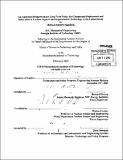| dc.contributor.advisor | Howard Herzog and Richard Lester. | en_US |
| dc.contributor.author | Hamilton, Michael Roberts | en_US |
| dc.contributor.other | Massachusetts Institute of Technology. Technology and Policy Program. | en_US |
| dc.coverage.spatial | n-us--- | en_US |
| dc.date.accessioned | 2010-10-29T18:11:55Z | |
| dc.date.available | 2010-10-29T18:11:55Z | |
| dc.date.copyright | 2010 | en_US |
| dc.date.issued | 2010 | en_US |
| dc.identifier.uri | http://hdl.handle.net/1721.1/59685 | |
| dc.description | Thesis (S.M. in Technology and Policy)--Massachusetts Institute of Technology, Engineering Systems Division, 2010. | en_US |
| dc.description | Cataloged from PDF version of thesis. | en_US |
| dc.description | Includes bibliographical references (p. 138-140). | en_US |
| dc.description.abstract | Carbon capture and sequestration (CCS) technology has the potential to be a key CO2 emissions mitigation technology for the United States. Several CCS technology options are ready for immediate commercial-scale demonstration, but three obstacles to commercial deployment remain: the lack of a clear legal and regulatory framework for sequestration, the lack of a demonstration phase, and most importantly, the lack of a market for CCS. A successful demonstration phase will achieve the goal of technology readiness. The demonstration phase should be organized so as to share costs and risks between public and private actors. Project selection responsibility should be assigned to a dedicated private board and project management responsibility to private companies. This analysis recommends a combination of the Boucher Bill proposal for a CCS demonstration phase, as incorporated in the American Clean Energy and Security Act (ACES Act) of 2009, and a continuation of the DOE Clean Coal Power Initiative program. This combined approach can provide productive competition between public and private demonstration programs. Achieving technology readiness will not on its own lead to commercial deployment of CCS. Two additional policy objectives for the commercial deployment phase are considered: market penetration and cost reduction. Market penetration can be ensured through strong market pull policies, but this may be a very expensive policy approach in the long run. A more prudent goal is long-term cost reduction of CCS. Unlike the market penetration goal, the cost reduction goal will not guarantee that CCS will become a major contributor to carbon emissions mitigation, but it will provide a more cost-effective path. Achieving the cost reduction goal will require strong market pull policies for the short and medium term, together with a focus on technology push policies over the entire period. In the long term, market pull policies for CCS should be eliminated; if CCS is not economically competitive with alternative technologies, it should not be deployed on a significant scale. The ACES Act provides a good policy framework to achieve technology readiness through a demonstration phase and to pursue the long-term goal of cost reduction for commercial deployment of CCS technology. This approach will provide a cost-effective strategy for ensuring that CCS, a major scalable option for carbon emissions mitigation, is given the best chance of success in the long term. | en_US |
| dc.description.statementofresponsibility | by Michael Roberts Hamilton. | en_US |
| dc.format.extent | 140 p. | en_US |
| dc.language.iso | eng | en_US |
| dc.publisher | Massachusetts Institute of Technology | en_US |
| dc.rights | M.I.T. theses are protected by
copyright. They may be viewed from this source for any purpose, but
reproduction or distribution in any format is prohibited without written
permission. See provided URL for inquiries about permission. | en_US |
| dc.rights.uri | http://dspace.mit.edu/handle/1721.1/7582 | en_US |
| dc.subject | Engineering Systems Division. | en_US |
| dc.subject | Technology and Policy Program. | en_US |
| dc.subject.lcsh | Carbon sequestration | en_US |
| dc.title | An analytical framework for long term policy for commercial deployment and innovation in carbon capture and sequestration technology in the United States | en_US |
| dc.type | Thesis | en_US |
| dc.description.degree | S.M.in Technology and Policy | en_US |
| dc.contributor.department | Massachusetts Institute of Technology. Engineering Systems Division | |
| dc.identifier.oclc | 668233009 | en_US |

